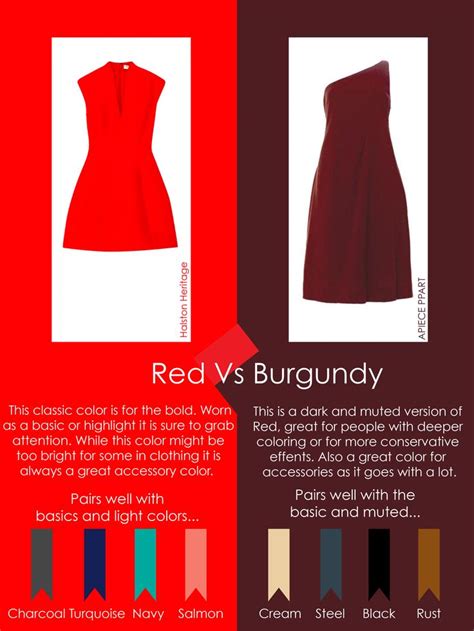The world of colors is vast and multifaceted, with countless hues, shades, and variations that add depth and vibrancy to our lives. Among this spectrum of colors, maroon and burgundy stand out as two sophisticated and elegant shades that evoke a sense of royalty, maturity, and refinement. While often used interchangeably, these two colors possess distinct characteristics that set them apart.

Origin and Etymology
Both maroon and burgundy have long and storied histories, tracing their origins back to centuries past.
-
Maroon: The name “maroon” is derived from the French word “marron,” which means “chestnut.” It is named after the deep reddish-brown color of roasted chestnuts.
-
Burgundy: Burgundy is named after the Burgundy region of France, where red wine made from Pinot Noir grapes has been produced for centuries. The color burgundy is inspired by the deep red color of these wines.
Color Characteristics
Although both maroon and burgundy fall within the red-brown spectrum, they exhibit slight differences in their hue and saturation:
-
Maroon: Maroon is a dark shade of red-brown with a higher concentration of blue undertones. It is often described as a “dark crimson” or “oxblood.”
-
Burgundy: Burgundy is a slightly lighter and warmer shade of red-brown with more orange undertones. It is reminiscent of the color of red wine or ripe plums.
Color Psychology and Symbolism
Colors evoke emotions and carry cultural significance. Maroon and burgundy are no exception:
-
Maroon: Maroon is associated with strength, power, and authority. It is often used in military uniforms, academic gowns, and royal regalia. It can also symbolize sadness, loss, and mourning.
-
Burgundy: Burgundy evokes feelings of luxury, sophistication, and indulgence. It is associated with wealth, nobility, and royalty. It can also symbolize passion, romance, and seduction.
Applications in Fashion and Design
Maroon and burgundy are highly versatile colors that find applications in various aspects of fashion and design:
-
Fashion: Maroon and burgundy are popular choices for formal wear, such as suits, dresses, and evening gowns. They are also used in casual clothing, accessories, and footwear.
-
Interior Design: Maroon and burgundy add warmth and elegance to interior spaces. They are used in curtains, upholstery, carpets, and wall paint to create sophisticated and inviting environments.
-
Automotive Design: Maroon and burgundy are classic colors used in high-end automobiles. They convey a sense of luxury, prestige, and timeless appeal.
-
Winemaking: Burgundy wines are renowned for their rich, full-bodied flavor profiles. They are typically made from Pinot Noir grapes grown in the Burgundy region of France.
Pain Points and Motivations
When considering maroon vs. burgundy, individuals may encounter certain pain points or motivations:
Pain Points:
-
Difficulty distinguishing the two colors: Some individuals may find it challenging to differentiate between maroon and burgundy, especially in low-light conditions.
-
Perception as “dated” or “dull”: Maroon and burgundy can be perceived as “dated” or “dull” by some, particularly when used in fashion or interior design.
Motivations:
-
Desire for sophistication and elegance: Individuals may be drawn to maroon and burgundy for their association with luxury, refinement, and timeless appeal.
-
Cultural or historical significance: Maroon and burgundy hold cultural and historical significance, particularly in regions where they are associated with specific traditions or events.
How to Choose Between Maroon and Burgundy
When making a choice between maroon and burgundy, consider the following factors:
-
Intended use: Consider the specific application for which you will be using the color. Maroon is more suitable for formal or traditional settings, while burgundy can be used in both formal and casual contexts.
-
Personal preferences: Ultimately, the best color for you is the one that aligns with your personal preferences and style. If you prefer bolder shades, maroon may be a better choice. If you prefer warmer, more inviting shades, burgundy is ideal.
-
Lighting conditions: Maroon and burgundy appear differently in different lighting conditions. Be sure to consider the lighting conditions under which the color will be used.
